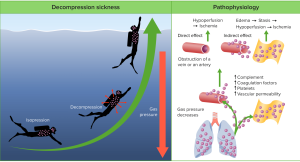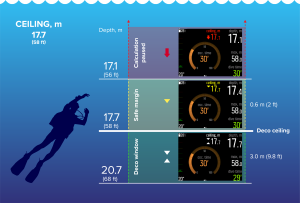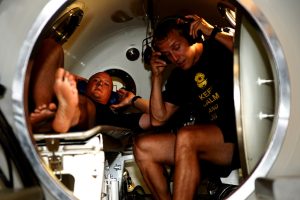
Decompression sickness, also known as "the bends," is a potentially life-threatening condition that can occur when a diver ascends too quickly from a deep dive. It is caused by the rapid expansion of gases in the body, which can lead to a variety of symptoms including joint pain, skin rash, dizziness, and difficulty breathing. In severe cases, decompression sickness can result in paralysis, brain damage, and even death.
 Decompression sickness occurs when a diver spends a significant amount of time at depths greater than 40 feet, breathing compressed air. At these depths, the pressure is much greater than at the surface, and the body absorbs more nitrogen from the air. When the diver ascends, the pressure decreases and the nitrogen expands, forming bubbles in the body's tissues and blood. These bubbles can cause a variety of problems, depending on where they form.
The most common symptoms of decompression sickness are joint pain and fatigue. These symptoms often occur in the elbows, shoulders, and knees, and can range from mild to severe. Other symptoms can include skin rash, dizziness, and difficulty breathing. In severe cases, decompression sickness can cause paralysis, brain damage, and even death.
There are several factors that can increase the risk of decompression sickness, including the depth and duration of the dive, the type of diving equipment used, and the diver's physical condition. Divers who are older, obese, or in poor physical condition are at greater risk of developing the bends. In addition, diving at depths greater than 100 feet or diving for extended periods of time can increase the risk of decompression sickness.
Decompression sickness occurs when a diver spends a significant amount of time at depths greater than 40 feet, breathing compressed air. At these depths, the pressure is much greater than at the surface, and the body absorbs more nitrogen from the air. When the diver ascends, the pressure decreases and the nitrogen expands, forming bubbles in the body's tissues and blood. These bubbles can cause a variety of problems, depending on where they form.
The most common symptoms of decompression sickness are joint pain and fatigue. These symptoms often occur in the elbows, shoulders, and knees, and can range from mild to severe. Other symptoms can include skin rash, dizziness, and difficulty breathing. In severe cases, decompression sickness can cause paralysis, brain damage, and even death.
There are several factors that can increase the risk of decompression sickness, including the depth and duration of the dive, the type of diving equipment used, and the diver's physical condition. Divers who are older, obese, or in poor physical condition are at greater risk of developing the bends. In addition, diving at depths greater than 100 feet or diving for extended periods of time can increase the risk of decompression sickness.
 To prevent decompression sickness, divers must follow proper dive procedures and use the correct equipment. This includes using a dive computer or dive tables to calculate the appropriate dive time and ascent rate, and using a dive watch or other device to monitor the dive. In addition, divers should avoid flying or traveling to high altitudes within 24 hours of diving, as the lower pressure at higher altitudes can cause gases to expand more rapidly.
To prevent decompression sickness, divers must follow proper dive procedures and use the correct equipment. This includes using a dive computer or dive tables to calculate the appropriate dive time and ascent rate, and using a dive watch or other device to monitor the dive. In addition, divers should avoid flying or traveling to high altitudes within 24 hours of diving, as the lower pressure at higher altitudes can cause gases to expand more rapidly.
 If a diver does develop decompression sickness, it is important to seek medical treatment as soon as possible. Treatment for decompression sickness typically involves administering 100% oxygen and placing the diver in a hyperbaric chamber, which can help to reduce the size of the nitrogen bubbles and improve symptoms. In severe cases, the diver may need to undergo surgery to remove the gas bubbles.
In conclusion, decompression sickness is a potentially life-threatening condition that can occur when a diver ascends too quickly from a deep dive. It is caused by the rapid expansion of gases in the body, and can lead to a variety of symptoms ranging from mild joint pain to severe paralysis and brain damage. To prevent decompression sickness, divers must follow proper dive procedures and use the correct equipment, and seek medical treatment if symptoms develop.
If a diver does develop decompression sickness, it is important to seek medical treatment as soon as possible. Treatment for decompression sickness typically involves administering 100% oxygen and placing the diver in a hyperbaric chamber, which can help to reduce the size of the nitrogen bubbles and improve symptoms. In severe cases, the diver may need to undergo surgery to remove the gas bubbles.
In conclusion, decompression sickness is a potentially life-threatening condition that can occur when a diver ascends too quickly from a deep dive. It is caused by the rapid expansion of gases in the body, and can lead to a variety of symptoms ranging from mild joint pain to severe paralysis and brain damage. To prevent decompression sickness, divers must follow proper dive procedures and use the correct equipment, and seek medical treatment if symptoms develop.
![]()
Decompression sickness occurs when a diver spends a significant amount of time at depths greater than 40 feet, breathing compressed air. At these depths, the pressure is much greater than at the surface, and the body absorbs more nitrogen from the air. When the diver ascends, the pressure decreases and the nitrogen expands, forming bubbles in the body's tissues and blood. These bubbles can cause a variety of problems, depending on where they form. The most common symptoms of decompression sickness are joint pain and fatigue. These symptoms often occur in the elbows, shoulders, and knees, and can range from mild to severe. Other symptoms can include skin rash, dizziness, and difficulty breathing. In severe cases, decompression sickness can cause paralysis, brain damage, and even death. There are several factors that can increase the risk of decompression sickness, including the depth and duration of the dive, the type of diving equipment used, and the diver's physical condition. Divers who are older, obese, or in poor physical condition are at greater risk of developing the bends. In addition, diving at depths greater than 100 feet or diving for extended periods of time can increase the risk of decompression sickness.
To prevent decompression sickness, divers must follow proper dive procedures and use the correct equipment. This includes using a dive computer or dive tables to calculate the appropriate dive time and ascent rate, and using a dive watch or other device to monitor the dive. In addition, divers should avoid flying or traveling to high altitudes within 24 hours of diving, as the lower pressure at higher altitudes can cause gases to expand more rapidly.
If a diver does develop decompression sickness, it is important to seek medical treatment as soon as possible. Treatment for decompression sickness typically involves administering 100% oxygen and placing the diver in a hyperbaric chamber, which can help to reduce the size of the nitrogen bubbles and improve symptoms. In severe cases, the diver may need to undergo surgery to remove the gas bubbles. In conclusion, decompression sickness is a potentially life-threatening condition that can occur when a diver ascends too quickly from a deep dive. It is caused by the rapid expansion of gases in the body, and can lead to a variety of symptoms ranging from mild joint pain to severe paralysis and brain damage. To prevent decompression sickness, divers must follow proper dive procedures and use the correct equipment, and seek medical treatment if symptoms develop.